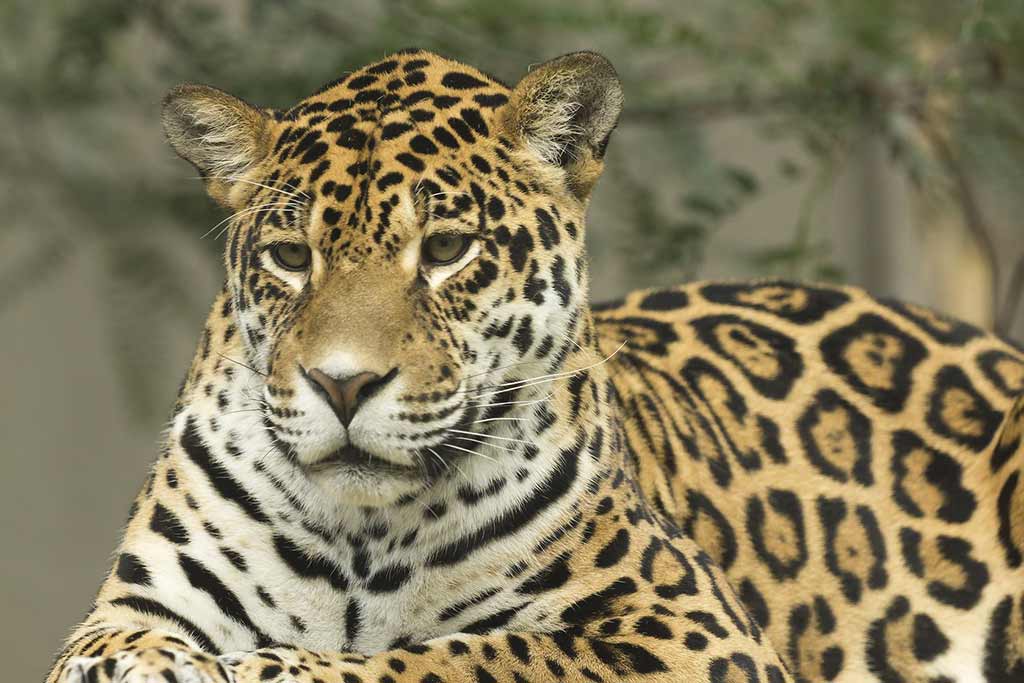Balam: Jaguars in Guatemala
Among the most beautiful and highly revered rainforest animals both in ancient and modern times is the jaguar (Panthera onca), which inhabits Mexico, Central America, and parts of South America. It is one of the big cats, along with the leopard, lion, and tiger, and the third largest of these. Jaguars are similar to leopards, though their spots present different arrangements (jaguars have spots within spots, or rosettes, and are larger). Jaguars are also stockier in build. They inhabit mostly forested lands but will also range across grasslands and open terrain. Also notable is their love of water and ability to swim. These gorgeous jungle cats are largely solitary and known for their hunting skills. They will attack cattle in areas fringing jungle zones and have been known to attack jungle camps to stalk human prey, usually children. Their powerful jaws are capable of puncturing tortoise shells.

Perhaps for these reasons, the Maya had great respect and reverence for the jaguar, which they called balam. Jaguars were a symbol of power and strength and were believed to act as mediums for communication between the living and the dead. Kings were often given names incorporating the word balam, which they viewed as their companions in the spiritual world and protectors of the royal household. Rulers wearing jaguar pelts and man-jaguar figures frequently appear in pre-Columbian art. The jaguar was the patron deity of Tikal and is featured in a royal burial scene depicted on a human bone fragment found in the burial tomb of Hasaw Chan K’awil (Heavenly Standard Bearer) in which the ruler travels to the underworld in a canoe rowed by mythical animal figures.
Ranges for female jaguars are in the vicinity of 25-40 square kilometers, with the range of males being roughly twice as much and encompassing that of 2-3 females. Male jaguars’ ranges do not overlap. For this reason, attempts to conserve existing numbers of jaguars require large expanses of territory such as that found in Guatemala’s Maya Biosphere Reserve. The reserve also adjoins reserves in neighboring Mexico and Belize as part of a vast biological corridor. An estimated 550-650 jaguars remain in the Maya Biosphere Reserve.
Scientists have been studying jaguars in the Maya Biosphere Reserve and are trying to get a more accurate estimate of their remaining numbers in addition to a greater understanding of their behavioral patterns. Within the Laguna del Tigre National Park, biologists have been using radio collars to track five jaguars and a puma in the area surrounding the site of Waka’ in an effort to determine migration patterns along an important biological corridor connecting this area with Mirador-Dos Lagunas-Río Azul National Park. It is not uncommon to see jaguar prints on the muddy trails in the vicinity of Waka’. Ironically, in 2006, a camera crew visiting the park to film a program on scarlet macaws for Guatemalan TV channel Guatevisión was unable to find any macaws but did manage to get a jaguar sighting on tape. Recent video monitoring along 15 stations in the central core of Tikal National Park detected seven jaguars during a two-month period. The Sierra del Lacandón National Park is also believed to harbor large numbers of these jungle cats.
Luckily, you don’t need to go traipsing through the jungle with a saucer of milk if you want to see a jaguar, though chances are it will see you first. Guatemala City’s excellent zoo has jaguars, as does Petén’s ARCAS wildlife rescue center. A jaguar cub was born in Guatemala City’s zoo as recently as 2003. Several zoos in the United States have partnered with facilities in Central America to breed jaguars in captivity. In California, Sacramento’s zoo welcomed the arrival of Tina, a Guatemalan jaguar, and Mulac, a male jaguar from Belize, in 2002.
As part of a larger regional initiative along with Mexico and Belize known as Selva Maya, local conservation group Defensores de la Naturaleza and Fundación Monte Carlo Verde launched the SalvaBalam campaign in 2006 aimed at increasing public awareness of the jaguar’s plight and raising funds for continued study of these fascinating creatures. The project is still active, but is now part of Defensores de la Naturaleza.
